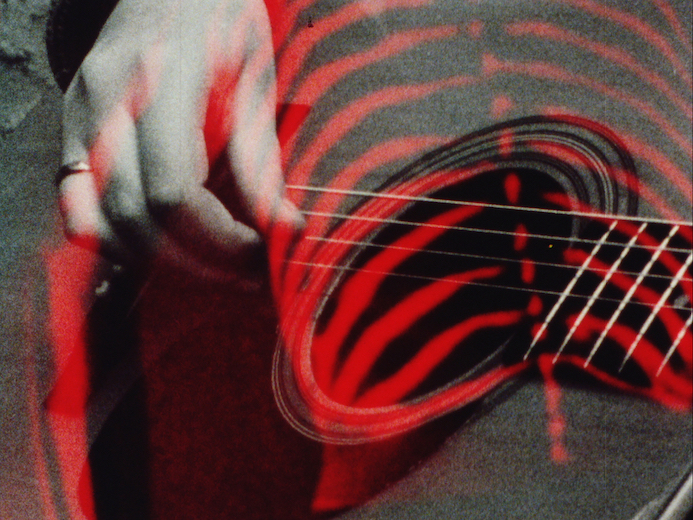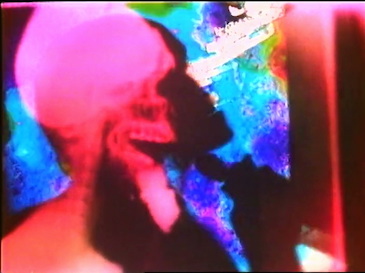In this post, I will consider how independently produced animations have contributed to the development of this medium today through films by Sandra Lahire (1950-2001) and Barbara Hammer (1939-2019). During the 1980s, both worked with animation in its widest sense, by manipulating photographic material. Such manual interception into live-action film provided the means to express concerns relating to the interdependence of bodily health and the broader ecology. I will focus on two aspects of their production practices: 1) the high recurrence of self-inscription, either through direct photographic imagery or through hand-drawn marks and colors; 2) how this graphic application of artificial colour to medical imagery of the body reveals its permeability.

Lahire enacts self-inscription in her early work (1984-6) predominantly through stop motion methods, the artist’s hands seen manipulating materials under the rostrum camera, a surrogate stage upon which she re-enacts and makes reparation for violence to bodies.[i] Later that decade, she redirected the camera from the broken parts on the rostrum, toward live-action film of mined and damaged landscapes. Yet through Lahire’s manual care for, and reworking of the photographic film, the sense of animation continues. In the nuclear trilogy, Serpent River (1989), Plutonium Blonde (1987), and Uranium Hex (1987), film is tended through repeated layering and multiple exposures of bodies and scenes of the land. Wearing a safety helmet, or completely covered by a lab coat, balaclava, and safety glasses, Lahire faces the camera, implicating herself within the polluted atmosphere that she briefly shares with the mining communities of these environments. In another shot, in mimicry of an X-ray, Lahire wears red lines drawn on her bodily surface that delineate her spine and lungs. This performed inversion of the inner and outer body is cut with actual X-ray imagery of damaged lungs, a montage that contradicts the idea that clothing can protect against radiation.

Likewise, much of Hammer’s work situates the artist as a witness to ill health and bodily disintegration, drawing parallels between scrutiny of the creative process and analysis of medical imaging. Optic Nerve (1985) allegorizes her grandmother’s deteriorating vision through experimental filmic visuals, such as upside-down film. Alternatively, in Sanctus (1999), she re-works the moving X-ray [ii] by colorizing the skeletal forms, painting directly onto film, forming vibrant backdrops of brilliant and ‘iridescent colors’ [iii] to the monochrome medical imaging. Although they are moving, these X-rayed bones and organs appear as though weightless and without solidity. As they raise their hollow arms to their lipless mouths, it is hard to relate to the phantasmagorical character of these anonymous skeletons. Hammer’s supplementary hand-drawn and scratched color palette seems to visualize the sensations felt by these living bodies that are absent in the medical visuals.

To reveal the permeability of the body and its interdependence with the environment, Lahire and Hammer deploy color that is either heightened, through superimpositions and hand-drawn coloring and tinting, or reduced, through monochrome X-ray imagery. It is important to consider Len Lye’s contribution to the development of color in independent animation. His hand made films deployed techniques of color separation, to intensify and render, ‘non-natural color’ (Curtis 2007: 136). Such color intensity is evident in Rainbow Dance (1936), where vibrant monochrome bodies appear as flat shapes, in lively, patterned environments. The horizontal curved stripes resemble the bony ribcage in Serpent River, yet while heightened color celebrates the healthy body in Rainbow Dance (see Smyth 2013), in the latter film it connotes the inflamed and ‘itchy’ feeling caused by exposure to radiation [iv]. As these films testify, shades such as the ‘canary color’ of processed uranium [v] do exist in nature but become harmful when displaced and refined. The response by these artists to the mining of land and body is to refine and process visual material, intensifying the photographic through distinctly superimposed color layers. Hammer and Lahire’s 1980s works have been compared previously, in terms of the apparitional and queer visibility,[vi] but the emphasis here is on how the graphic application of color to the photographic reveals that which remain outside of our senses. Animation has the capacity to represent many worlds (e.g., see Buchan 2007), and through their ability to give form to the invisible, Hammer and Lahire contribute to independent animation today.
References
Buchan, S. (e.d.) (2007) Animated Worlds, New Barnet: John Libbey.
Curtis, D. (2009) A History of Artists Film and Video in Britain, London: BFI.
Jacquin, M. (2019) ‘Overexposed, like an X-ray’: The Politics of Corporeal Vulnerability in Sandra Lahire’s Experimental Cinema’, in Reynolds, Lucy. Women Artists, Feminism and the Moving Image: Contexts and Practices, London/New York: Bloomsbury Collections, pp. 127-138.
Smyth, L. (2013). ‘Len Lye: The Vital Body of Cinema’, October 144, pp. 73- 91.
Dr Vicky Smith practices and researches in experimental animation. Her work screens internationally, in galleries and festivals. She runs workshops in experimental film practice and has curated film screenings, including Go, Go, Go! Women in Experimental Animation (Cube Cinema, Bristol 2019). Recent publications include: Experimental & Expanded Animation: Current Perspectives and Practices, co-edited with Nicky Hamlyn (2018) and Not (A) Part: Handmade animation, materialism and eco-aesthetic cinema in Animation Practice, Production & Process issue 7 (2019). She lectures at the University for the Creative Arts, Farnham.
[i] I have previously discussed Lahire’s early rostrum animation: https://blog.animationstudies.org/?p=2174
[ii] The moving X-ray was invented in the 1950s by Dr James Sibley Watson, a New York-based medical doctor and filmmaking enthusiast.
[iii] Esther Schlict curated a major retrospective of camera-less film at Kunsthalle, Frankfurt (2010) .
See also exhibition publication Schlict, Esther (2010). Celluloid: Film Ohne Kamera. Berlin: Kerber Verlag.
[iv] Interview recordings of a commentary of a worker in the radiation plant in Serpent River.
[v] Interview recordings of a description of the treatment of uranium in Uranium Hex.
[vi] ‘The Apparitional’ in Hammer and Lahire films, within the context of the X-ray, the uncanny and ghostliness. Film screening at Birkbeck, London, May 2016 curated by Ricardo Matos Cabo and Selina Robertson. See also Jacquin 2019.
